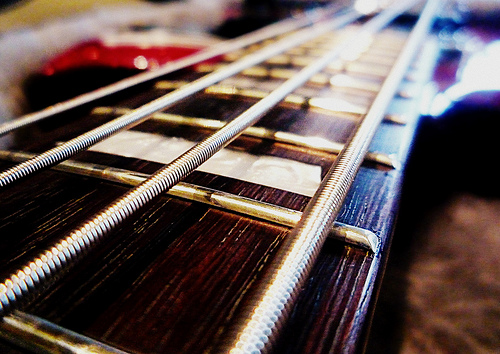Today, many recognize the bass guitar, usually called simply ‘the bass,’ as one of the leading musical instruments in the world, well known for inspiring various musicians and genres of music. How did the bass guitar come to be the popular instrument it is today?

Early Days of the Bass
While we can trace the origins of the double bass back to early string instruments from the 15th century, the bass guitar as we know it today didn’t come into being until the 1930s.
Paul Tutmarc, a musician from Seattle, was the first to present an electronic bass in current form. He was inspired to create the instrument so that he could create a bass line from a guitar shaped instrument, rather than exclusively from the double bass. Despite continuing to innovate with bass guitar variations up to the end of the 1940s, these early editions were never a success.
Enter Leo Fender
By the 1950s, Gibson were already dominating the overall guitar market, and while Leo Fender was producing his own electric guitars to rival Gibson’s, he was able to steal a march with the electric bass. The 1951 Fender Precision lent several of the features from the Fender Telecaster, and quickly became the industry standard for bass guitars.
Musicians would gradually start picking up the electric bass towards the end of the decade, with Bill Black, touring with Elvis Presley’s band, being one of the more notable to do so.
While Fender and Gibson continued to lead the way, companies from around the world were soon producing their own electric bass models.
The Explosion of Rock and Roll
As The Beatles, The Rolling Stones, and dozens of other bands hit the exploding 1960s music scene, so instrument production skyrocketed, too.
Fender introduced the Jazz Bass in 1960, and later the Mustang Bass. Although the latter would become the favoured instrument of several top musicians, including the Stones’ Bill Wyman, Gibson would begin to claw back some of Fender’s market dominance, in part due to their fame in producing standard electric guitars.
1970s and Later Years
While the 1950s and 60s set the tone for what the bass would bring to music, from the 1970s onward musicians and instrument designers would begin to experiment with different ideas and innovations.
One of the first would be Alembic, who would produce custom-built instruments and set what is still today’s standard for ‘boutique’ guitars. Different varieties of bass would also start to become associated with various music genres, allowing progressive bands of the time such as Rush to create a more definitive, unique sound.
Five-string basses also started to be produced in the 70s, although these wouldn’t become widely available at consumer-friendly prices until the 90s, when six, seven, and even eight string variants would be pioneered.
Other customisations, such as the headless bass, would become popular in the 80s, but are rarely seen today due to their status as gimmick or novelty instruments.
Despite these later innovations, the Fender Precision and Jazz bass guitars remain the most popular instruments to this day.
Image Source: AJU_photography
Are you a guitarist? Check out our full range of online guitar lessonsAre you a saxophonist? Check out our full range of online saxophone lessons
Subscribe to Pro Music Tutor from as little as £7.99 per month
Related Posts
-
Is Music Theory Important to Modern Musicians?
The importance of music theory is a hot debate topic in the world of professional music. Some believe knowledge of music theory is what makes you a true musician, whereas some feel their lack of music theory knowledge is like a badge of honour. With the eternal debate over the importance of music theory raging […]
View All >> -
5 Ways Spanish Music Influenced the World
Contemporary popular music has transcended all national boundaries, with different types of music being performed and listened to in all corners of the world. Each culture also adds their own little tweaks and twists to the music, constantly creating new sounds and influences. Spanish music has deeply influenced the popular music we listen to today. […]
View All >>
Latest Blog Entries
-
The Benefits of Online Music Education
Learning music has never been easier, since the internet and modern technological advancements have opened the doors to countless possibilities, expanding the subjects people can choose from and how the lessons are taught. Now, people can study a whole host of music-related topics; from learning to play guitar or DJing, to understanding the inner workings […]
View All >> -
Essential Jazz Guitar Scales that are Easy to Learn
Improvising in jazz requires the ability to play in different keys over different chords. Results certainly do not come overnight, but with diligent practice, you would be surprised by what you can achieve. Many people ask me about what scales I use as if they were some big secret. While knowing your scales is very […]
View All >>
Blog Categories
- Categories
- Guitar Tips (93)
- History (36)
- How-To (38)
- Interviews (3)
- Music Industry (121)
- Prolinks Guitar (2)
- Prolinks Lessons (3)
- Prolinks Tutor's Profile (1)
- Saxophone Tips (40)
- Uncategorized (6)
Tags
Archive
- November 2018 (1)
- February 2018 (1)
- December 2017 (1)
- November 2017 (1)
- October 2017 (1)
- July 2017 (4)
- May 2017 (2)
- April 2017 (1)
- August 2016 (2)
- July 2016 (1)
- June 2016 (2)
- May 2016 (3)

